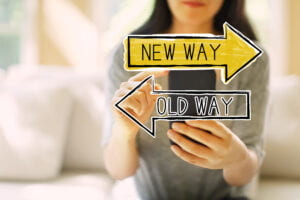
By Rick Valachovic, DMD, MPH, Clinical Professor and Director of the NYU Dentistry Center for Oral Health Policy and Management
Summer is nearly here, and while the pandemic is far from over, people have resumed many of the activities they put on hold when COVID-19 arrived. For me, that has meant traveling to conferences, including the American Dental Education Association (ADEA) Annual Session held in Philadelphia in March. I was impressed that almost 2,000 other ADEA members joined me. The pleasure of reconnecting with old friends was comforting and familiar, but the meeting felt and looked different as well. Women and people of color dominated the stage, and the election of Puerto Rico’s Ana López-Fuentes to succeed ADEA Board Chairs Nader Nadershahi, Keith Mays, and Ryan Quok made one thing abundantly clear:
1.
Diversity in leadership will be the expectation, not the exception, as we enter the next normal.
The following week, I logged on to the annual gathering of the American Association for Dental Research, which held a hybrid meeting in Atlanta. From my perspective, hybrid is the way to go. The technology is there and it’s not expensive to do, and it answers a question we often posed when I was at ADEA: How do we get this great content to more people? The take-away?
2.
Organizations will take advantage of virtual meeting technologies, even if COVID-19 case numbers continue to remain low.
As I write, omicron and its subvariants continue to sicken Americans, including those who have been vaccinated and boosted, and while no one is panicking, many in our community continue to mask and take other precautions even without mandates. Much of the public seems to associate the word “endemic” with “benign.” Health professionals know better. Endemic means we’ll be living with the risks of this disease for some time to come, probably decades. Some regions may eradicate it through vaccination and natural immunity (think measles or polio), but in other regions it will continue to make people sick and die, and more potent variants may well emerge and drive new surges. As a result,
3.
Navigating different perceptions of public health risk will continue to challenge us for the foreseeable future.
In the meantime, the current pandemic continues to pose economic challenges and to have especially negative effects on the health care delivery system and its workforce. Dental practices were not immune. According to research by the American Dental Association Health Policy Institute (ADA HPI), patient volume remained 10% lower than pre-pandemic levels in October 2021, and at the start of this year, shortages of dental assistants and hygienists continued to stymie efforts to return practices to full productivity. What does this mean for the next normal? Writing in Dental Economics, ADA HPI staff observed…
4.
“Practices need to think creatively not only about recruitment, but also staff retention.” Cross-training, professional development opportunities, and technological solutions, in addition to pay increases, were among the strategies they proposed.
As we picture the future, we should also remember that many people will continue to live with the long-term health consequences of COVID-19, and their long-lasting symptoms will have downstream effects — disrupting housing, employment, and family life. I can’t help thinking about all the members of the armed forces who escape the battlefield but spend years rebuilding their bodies and minds. From our work with veterans here at NYU Dental, we know,
5.
Recovery is possible, but it takes substantial will, support, and resources.
For people who were healthy and economically secure, the pandemic spurred several positive developments that will almost certainly be part of the next normal. Many white-collar workers will continue to work from home, sparing them stressful commutes and reducing vehicle pollution. Organizations will take advantage of the reduced costs and increased productivity this arrangement creates. Educators who previously taught exclusively face-to-face have grown comfortable with engaging adult learners online. And perhaps most consequentially,
6.
Telehealth is here to stay.
In the early days of the pandemic, when people were advised to shelter in their homes, patients’ willingness to communicate with their health care providers via telehealth was unknown. No longer. The technology was widely embraced by patients and providers alike. In dentistry, telehealth allowed practices to triage patients during dental emergencies. Dentists also met with patients remotely to review their medical histories. And the experience encouraged dental providers to think about how the technology might become part of their next normal.
Not everyone in our community is ready to incorporate teledentistry into their practices, and an ADEA report makes clear most schools need to do more to prepare students for this type of practice. Luckily, dentistry has pioneers who can guide our path forward. In the past two decades, colleagues at the University of the Pacific Arthur A. Dugoni School of Dentistry used teledentistry to create their Virtual Dental Home; the University of Minnesota School of Dentistry established a teledentistry network linking university specialists to dentists and patients in remote rural areas; and the University of North Carolina Adams School of Dentistry launched a teledentistry service that is increasing access to care in that state.
We can also look to the experience of the Alaska Native Tribal Health Consortium (ANTHC), which has improved oral health outcomes for residents of the Yukon Kuskokwim Delta by using remote technologies to facilitate the work of dental therapists since 2006. Delivering dental care remotely is not as easy as providing mental health counseling from afar, but these efforts show that with the right training, certification, and team structures, technology can help us improve how we care for underserved populations as we enter the next normal.
One more thought about where we’re headed. The pandemic accelerated the proliferation of misinformation and disinformation, forcing members of the academic, practice, and public health communities to contend with heightened levels of hostility from ill-informed members of the public. In such an environment, it’s essential that students learn how to communicate effectively with patients and analyze the research literature – an area where NYU Dentistry excels. Since 2000, literature appraisal has been a cornerstone of our effort to prepare students for evidence-based practice. As a result, our students don’t simply conform when faculty say, “Do it this way.” They ask us, “Why?”
WARNING:
With the COVID-19 pandemic accelerating the erosion of trust in government and public institutions, the public will continue to ask for compelling reasons to take our advice regarding their oral health. Preparing ourselves and the rising generation of oral health providers to provide persuasive answers must also be part of our next normal.
